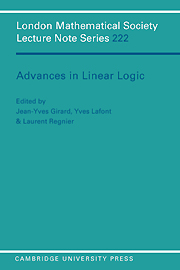Book contents
- Frontmatter
- Contents
- Preface
- Linear Logic: its syntax and semantics
- Part I Categories and semantics
- Part II Complexity and expressivity
- Part III Proof theory
- Part IV Proof nets
- From proof nets to interaction nets
- Empires and kingdoms in MLL-
- Noncommutative proof nets
- Volume of mulitplicative formulas and provability
- Part V Geometry of interaction
From proof nets to interaction nets
Published online by Cambridge University Press: 17 February 2010
- Frontmatter
- Contents
- Preface
- Linear Logic: its syntax and semantics
- Part I Categories and semantics
- Part II Complexity and expressivity
- Part III Proof theory
- Part IV Proof nets
- From proof nets to interaction nets
- Empires and kingdoms in MLL-
- Noncommutative proof nets
- Volume of mulitplicative formulas and provability
- Part V Geometry of interaction
Summary
Introduction
If we consider the interpretation of proofs as programs, say in intuitionistic logic, the question of equality between proofs becomes crucial: The syntax introduces meaningless distinctions whereas the (denotational) semantics makes excessive identifications. This question does not have a simple answer in general, but it leads to the notion of proof-net, which is one of the main novelties of linear logic. This has been already explained in [Gir87] and [GLT89].
The notion of interaction net introduced in [Laf90] comes from an attempt to implement the reduction of these proof-nets. It happens to be a simple model of parallel computation, and so it can be presented independently of linear logic, as in [Laf94]. However, we think that it is also useful to relate the exact origin of interaction nets, especially for readers with some knowledge in linear logic. We take this opportunity to give a survey of the theory of proof-nets, including a new proof of the sequentialization theorem.
Multiplicatives
First we consider the kernel of linear logic, with only two connectives: ⊗ (times or tensor product) and its dual ℘ (par or tensor sum). The first one can be seen as a conjunction and the second one as a disjunction. Each atom has a positive form p and a negative one p⊥ (the linear negation of p).
Information
- Type
- Chapter
- Information
- Advances in Linear Logic , pp. 225 - 248Publisher: Cambridge University PressPrint publication year: 1995
Accessibility standard: Unknown
Why this information is here
This section outlines the accessibility features of this content - including support for screen readers, full keyboard navigation and high-contrast display options. This may not be relevant for you.Accessibility Information
- 52
- Cited by
